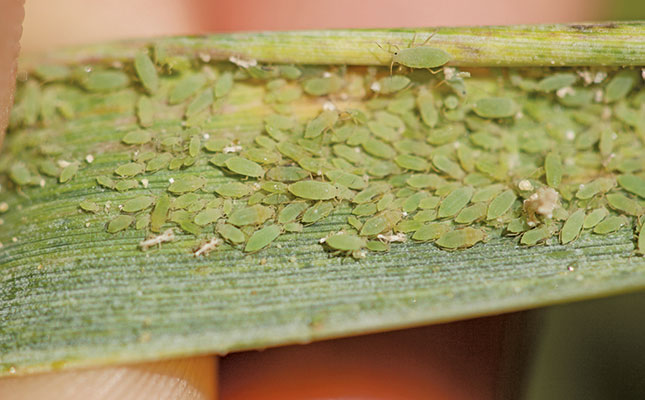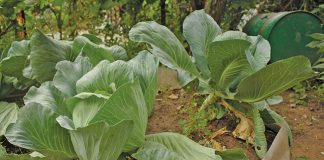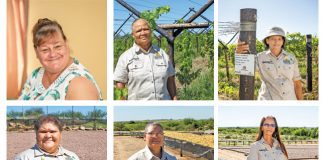
Photo: Dr Astrid Jankielsohn
The Russian wheat aphid (Diuraphis noxia) occurs worldwide where wheat is produced at commercial scale. South Africa currently has five biotypes affecting production, one of which was recorded for the first time in 2018.
It was identified by Dr Astrid Jankielsohn, an insect ecologist at the Agricultural Research
Council’s Small Grains Institute in Bethlehem in the Free State. The Russian wheat aphid (RWA) is native to south-western Asia and was introduced into many European countries in the 20th century.
It was first noted as a pest in the Crimea in 1901, hence the common name. The aphid, which is up to 2mm long, is light green in colour and has a tiny spike at the rear above its tail, giving the impression of two tails.
The insect feeds on leaves, causing them to turn white and curl up. The main damage,
however, is done by the saliva of this pest, which is toxic and stunts growth. Research has
also found that aphid infestation affects the flour made from infested wheat plants.
The Food and Agriculture Organization of the United Nations regards RWA as a serious threat to dryland wheat in many developing countries beset by sporadic drought. In
Europe, Africa, Asia, and North and South America, RWA has caused crop losses of up to 80%.
Control measures
According to Jankielsohn, much effort is being invested into developing control strategies. The two most widely used of these are chemical control measures and breeding for resistance, but both have drawbacks.
“Chemical control results in environmental damage, especially to insect groups
like pollinators, predators and decomposers. We need those insects to be present in our
ecosystems,” she explains.
Problems are also created by using chemicals with the same active ingredients over long periods.
“This means a very high likelihood of resistance that renders this control method useless.”
Only a limited selection of active ingredients are registered for RWA control in South Africa,
says Jankielsohn. These include acetamiprid, chlorpyrifos, demeton-S-methyl, dimethoate,
imidacloprid, parathion, prothiofos and thiamethoxam.
Of these, chlorpyrifos is the most widely used in South Africa and elsewhere.
“It’s systemic and provides fast knock-down of aphids, and is the only active ingredient
that can effectively control RWA after the aphids enter rolled-up wheat leaves in later
colonisation stages,” she says.
Unfortunately, while chlorpyrifos is effective on a wide range of insect pest species and is
used by farmers as a preventative application for grain aphids, it also kills beneficial insects, such as pollinators and predators.
“The wide and continuous use of one active ingredient has the potential of causing resistance in the target insect and also weakening the predator complex,” explains Jankielsohn.
“When resistance develops in the target insect, there’s nothing to keep this insect under the damage threshold in the absence of the predator complex.”
She advocates continual monitoring of lands and only using chemicals when absolutely
necessary to protect yield. In addition, practices such as crop rotation and inter-and cover-cropping will limit the availability of RWA host plants and prevent large populations
from surviving from one season to the next, she says.
Breeding for resistance
Turning to the second control measure, breeding for resistance, Jankielsohn says that its
drawback “is that insect pest populations eventually adapt to overcome resistance and
render the strategy useless”.
She has been tracking RWA distribution, as well as investigating resistance problems,
for several years. The pest was first recorded in South Africa in 1978, and researchers
have become concerned about increasing resistance among different biotypes, as well as the high virulence of new biotypes.
Until 2018, four RWA biotypes were known in South Africa.
“During 2018, there were reports of wheat cultivars, resistant to all four biotypes,
which showed RWA damage symptoms in the field at Reitz and Danielsrus,” says Jankielsohn.
“Screening of RWA samples collected in these areas confirmed that a new biotype, with
additional virulence to the Dnx resistant gene (see panel) in wheat, was occurring in these areas.”
By then, the new biotype, RWASA5, had been recorded at eight different sites in the eastern Free State.
“It’s the most virulent RWA biotype recorded to date,” adds Jankielsohn.
The pest can exist in environments in which it has established itself, as well as adapt to changing environments by developing new biotypes.
In recent years, Jankielsohn has conducted surveys in several of South Africa’s major
wheat production regions, and has found that RWASA1 is the most widely distributed
biotype. It occurs mainly in the Western Cape, however, and was the only biotype
recorded in that region in 2018.
Although all known biotypes were found in the Free State in 2018, RWA was barely
present in the province’s western production regions.
“For example, there was only one land in the Wesselsbron/Theunissen area that was infested by RWASA1,” notes Jankielsohn.
The eastern Free State was a different matter, with infestations of all four biotypes, as well as the first recording of the new biotype, mostly in the Reitz area, but also in Clocolan.
Interestingly, the virulent new RWASA5 topped the biotype complex in the region, with a share of 15,4%, followed by RWASA3 (7,7%), RWASA4 (5,8%), RWASA2 (3,85%) and RWASA1 (1,92%).
By 2019, Jankielsohn still noted low incidences of infestations in the western Free State
areas, but saw that RWASA5 populations had increased and spread throughout the entire
eastern Free State region.
According to her, different management practices are being employed in different areas, particularly those that differ in terms of seasonal rainfall. Farmers in the Western Cape, for example, use solely chemical control strategies.
“In the Western Cape, they never rely on resistant wheat cultivars. Farmers grow
susceptible plants and rely on chemicals to overcome RWA,” she explains.
This is why only RWASA1 infestations have been recorded in that region. However, there are indications of growing insecticide resistance there.
In contrast, farmers in the Free State tend to favour cultivar resistance management. This,
however, has resulted in the creation of the four additional biotypes, all deemed more virulent than RWASA1.
“The conclusion is that we are creating resistance,” says Jankielsohn.
Tackling the problem
Jankielsohn is convinced that the solution is to focus on sustainable practices that will
address current challenges, as well as facilitate future control.
She suggests, for example, that farmers change cropping practices by moving away from
monoculture and following intercropping programmes.
She also advocates decreasing host plants for RWA, as well as creating diversity within crops.
“Don’t plant the same cultivar with the same genetic background in the same area every year, for example,” she says.
She also calls on approaches that limit insecticide resistance.
“Stop preventative spraying. Rather scout and only spray when necessary.”
Jankielsohn also advises farmers to alternate pesticide products with different active
ingredients so as to prevent creating populations resistant to specific active ingredients.
Another solution Jankielsohn champions is biological control.
“One could increase suitable habitats for other insects such as predators. Sufficient
numbers of predator insects could eventually maintain RWA threshold populations,” she says.
• Based on a presentation given by Dr Astrid Jankielsohn at the annual Combined Congress of crop production, soil, horticulture and weed sciences in January.
Email Dr Astrid Jankielsohn at [email protected].










